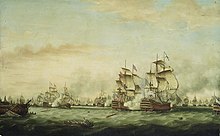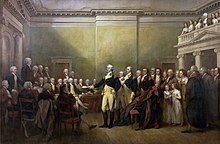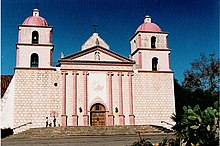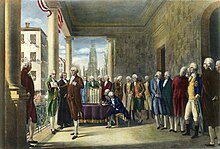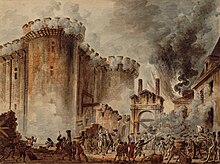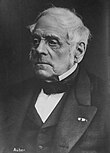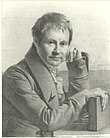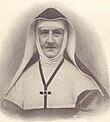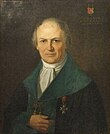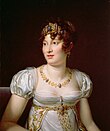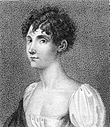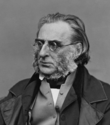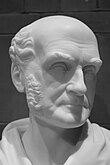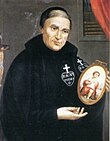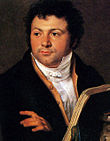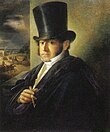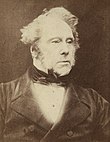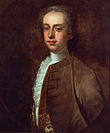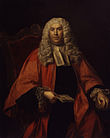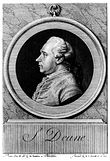
1787 (MDCCLXXXVII) was a common year starting on Monday of the Gregorian calendar and a common year starting on Friday of the Julian calendar, the 1787th year of the Common Era (CE) and Anno Domini (AD) designations, the 787th year of the 2nd millennium, the 87th year of the 18th century, and the 8th year of the 1780s decade. As of the start of 1787, the Gregorian calendar was 11 days ahead of the Julian calendar, which remained in localized use until 1923.

The 1770s was a decade of the Gregorian calendar that began on January 1, 1770, and ended on December 31, 1779. A period full of discoveries, breakthroughs happened in all walks of life, as what emerged at this period brought life to most innovations we know today.
1789 (MDCCLXXXIX) was a common year starting on Thursday of the Gregorian calendar and a common year starting on Monday of the Julian calendar, the 1789th year of the Common Era (CE) and Anno Domini (AD) designations, the 789th year of the 2nd millennium, the 89th year of the 18th century, and the 10th and last year of the 1780s decade. As of the start of 1789, the Gregorian calendar was 11 days ahead of the Julian calendar, which remained in localized use until 1923.

1782 (MDCCLXXXII) was a common year starting on Tuesday of the Gregorian calendar and a common year starting on Saturday of the Julian calendar, the 1782nd year of the Common Era (CE) and Anno Domini (AD) designations, the 782nd year of the 2nd millennium, the 82nd year of the 18th century, and the 3rd year of the 1780s decade. As of the start of 1782, the Gregorian calendar was 11 days ahead of the Julian calendar, which remained in localized use until 1923.

1796 (MDCCXCVI) was a leap year starting on Friday of the Gregorian calendar and a leap year starting on Tuesday of the Julian calendar, the 1796th year of the Common Era (CE) and Anno Domini (AD) designations, the 796th year of the 2nd millennium, the 96th year of the 18th century, and the 7th year of the 1790s decade. As of the start of 1796, the Gregorian calendar was 11 days ahead of the Julian calendar, which remained in localized use until 1923.
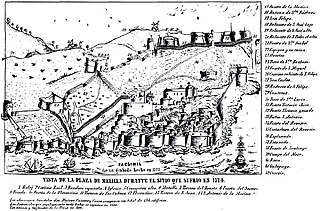
1774 (MDCCLXXIV) was a common year starting on Saturday of the Gregorian calendar and a common year starting on Wednesday of the Julian calendar, the 1774th year of the Common Era (CE) and Anno Domini (AD) designations, the 774th year of the 2nd millennium, the 74th year of the 18th century, and the 5th year of the 1770s decade. As of the start of 1774, the Gregorian calendar was 11 days ahead of the Julian calendar, which remained in localized use until 1923.

1794 (MDCCXCIV) was a common year starting on Wednesday of the Gregorian calendar and a common year starting on Sunday of the Julian calendar, the 1794th year of the Common Era (CE) and Anno Domini (AD) designations, the 794th year of the 2nd millennium, the 94th year of the 18th century, and the 5th year of the 1790s decade. As of the start of 1794, the Gregorian calendar was 11 days ahead of the Julian calendar, which remained in localized use until 1923.

1800 (MDCCC) was an exceptional common year starting on Wednesday of the Gregorian calendar and a leap year starting on Sunday of the Julian calendar, the 1800th year of the Common Era (CE) and Anno Domini (AD) designations, the 800th year of the 2nd millennium, the 100th and last year of the 18th century, and the 1st year of the 1800s decade. As of the start of 1800, the Gregorian calendar was 11 days ahead of the Julian calendar, which remained in localized use until 1923.

1819 (MDCCCXIX) was a common year starting on Friday of the Gregorian calendar and a common year starting on Wednesday of the Julian calendar, the 1819th year of the Common Era (CE) and Anno Domini (AD) designations, the 819th year of the 2nd millennium, the 19th year of the 19th century, and the 10th and last year of the 1810s decade. As of the start of 1819, the Gregorian calendar was 12 days ahead of the Julian calendar, which remained in localized use until 1923.
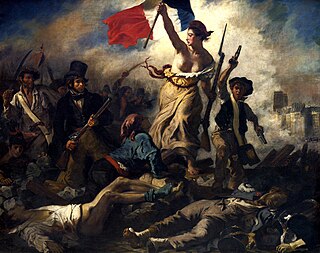
1830 (MDCCCXXX) was a common year starting on Friday of the Gregorian calendar and a common year starting on Wednesday of the Julian calendar, the 1830th year of the Common Era (CE) and Anno Domini (AD) designations, the 830th year of the 2nd millennium, the 30th year of the 19th century, and the 1st year of the 1830s decade. As of the start of 1830, the Gregorian calendar was 12 days ahead of the Julian calendar, which remained in localized use until 1923.

1803 (MDCCCIII) was a common year starting on Saturday of the Gregorian calendar and a common year starting on Thursday of the Julian calendar, the 1803rd year of the Common Era (CE) and Anno Domini (AD) designations, the 803rd year of the 2nd millennium, the 3rd year of the 19th century, and the 4th year of the 1800s decade. As of the start of 1803, the Gregorian calendar was 12 days ahead of the Julian calendar, which remained in localized use until 1923.
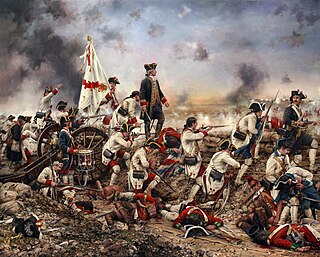
1781 (MDCCLXXXI) was a common year starting on Monday of the Gregorian calendar and a common year starting on Friday of the Julian calendar, the 1781st year of the Common Era (CE) and Anno Domini (AD) designations, the 781st year of the 2nd millennium, the 81st year of the 18th century, and the 2nd year of the 1780s decade. As of the start of 1781, the Gregorian calendar was 11 days ahead of the Julian calendar, which remained in localized use until 1923.

1836 (MDCCCXXXVI) was a leap year starting on Friday of the Gregorian calendar and a leap year starting on Wednesday of the Julian calendar, the 1836th year of the Common Era (CE) and Anno Domini (AD) designations, the 836th year of the 2nd millennium, the 36th year of the 19th century, and the 7th year of the 1830s decade. As of the start of 1836, the Gregorian calendar was 12 days ahead of the Julian calendar, which remained in localized use until 1923.

1783 (MDCCLXXXIII) was a common year starting on Wednesday of the Gregorian calendar and a common year starting on Sunday of the Julian calendar, the 1783rd year of the Common Era (CE) and Anno Domini (AD) designations, the 783rd year of the 2nd millennium, the 83rd year of the 18th century, and the 4th year of the 1780s decade. As of the start of 1783, the Gregorian calendar was 11 days ahead of the Julian calendar, which remained in localized use until 1923.

1795 (MDCCXCV) was a common year starting on Thursday of the Gregorian calendar and a common year starting on Monday of the Julian calendar, the 1795th year of the Common Era (CE) and Anno Domini (AD) designations, the 795th year of the 2nd millennium, the 95th year of the 18th century, and the 6th year of the 1790s decade. As of the start of 1795, the Gregorian calendar was 11 days ahead of the Julian calendar, which remained in localized use until 1923.

1780 (MDCCLXXX) was a leap year starting on Saturday of the Gregorian calendar and a leap year starting on Wednesday of the Julian calendar, the 1780th year of the Common Era (CE) and Anno Domini (AD) designations, the 780th year of the 2nd millennium, the 80th year of the 18th century, and the 1st year of the 1780s decade. As of the start of 1780, the Gregorian calendar was 11 days ahead of the Julian calendar, which remained in localized use until 1923.

1778 (MDCCLXXVIII) was a common year starting on Thursday of the Gregorian calendar and a common year starting on Monday of the Julian calendar, the 1778th year of the Common Era (CE) and Anno Domini (AD) designations, the 778th year of the 2nd millennium, the 78th year of the 18th century, and the 9th year of the 1770s decade. As of the start of 1778, the Gregorian calendar was 11 days ahead of the Julian calendar, which remained in localized use until 1923.

1777 (MDCCLXXVII) was a common year starting on Wednesday of the Gregorian calendar and a common year starting on Sunday of the Julian calendar, the 1777th year of the Common Era (CE) and Anno Domini (AD) designations, the 777th year of the 2nd millennium, the 77th year of the 18th century, and the 8th year of the 1770s decade. As of the start of 1777, the Gregorian calendar was 11 days ahead of the Julian calendar, which remained in localized use until 1923.

1775 (MDCCLXXV) was a common year starting on Sunday of the Gregorian calendar and a common year starting on Thursday of the Julian calendar, the 1775th year of the Common Era (CE) and Anno Domini (AD) designations, the 775th year of the 2nd millennium, the 75th year of the 18th century, and the 6th year of the 1770s decade. As of the start of 1775, the Gregorian calendar was 11 days ahead of the Julian calendar, which remained in localized use until 1923.

1776 (MDCCLXXVI) was a leap year starting on Monday of the Gregorian calendar and a leap year starting on Friday of the Julian calendar, the 1776th year of the Common Era (CE) and Anno Domini (AD) designations, the 776th year of the 2nd millennium, the 76th year of the 18th century, and the 7th year of the 1770s decade. As of the start of 1776, the Gregorian calendar was 11 days ahead of the Julian calendar, which remained in localized use until 1923.


